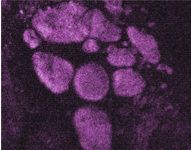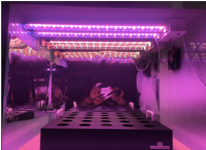IN THIS EDITION:
Why the time is ripe for mid-infrared

Infrared has been recognized as the source of thermal radiation for over 200 years, yet it is still an area of active research. This article looks at the IR spectrum and some recent developments in biomedical imaging with MIR light for personalized medicine and cancer research.
#Trestleoptics #microscope #mid-infrared
Our big plans for 2019

Trestle is proud to announce that our team, in partnership with Vertical Irrigation (VI; Fresno, CA), are recipients of the 2019 Innovative Irrigation Consortium award! Together with Colorado State Ft. Collins we are developing the most sophisticated indoor farming technology on the market.
#Trestlegrow #indoorfarming #growlights
MESSAGE FROM THE PRESIDENT

Thank you for taking the time to read our first e-newsletter! For 2019 and beyond, we plan to grow our catalog to better serve our customers. Stay tuned for new products, we are hard at work tackling R&D. I look forward to sharing our progress in future newsletters.
Adam Hanninen, PhD
CEO

(wikicommons)
The infrared is an especially enlightening part of the electromagnetic spectrum occupying the region just below optical frequencies. Though invisible to our eyes, we can perceive the infrared through thermal radiation, or heat, as infrared is where objects near room temperature (and body temperature) emit blackbody radiation the strongest. Infrared (IR) was first discovered by Sir William Herschel in 1800 while he was measuring spectral lines from stars, using a telescope, prism, and a thermometer which is how he measured radiation he could not see. Today we use photodiode sensors similar to the silicon CCD chips in digital cameras, but with materials that have a smaller bandgap such as high performance InSb and MCT sensors.
For practical purposes, the infrared can be broken down into four sections, near-infrared (NIR) which is closest to the visible and has wavelengths between 800nm – 1500nm, short-wave infrared (SWIR) between 1500nm – 3000nm, mid-wave infrared (MIR) from 3.0um – 10um, and long-wave infrared (LWIR) from 10um –30um. Though each subcategory has copious utilities, it is the NIR and MIR that dominate discussions of biomedical applications. NIR is home to some of the premiere laser sources of our time including the Ti:Sapphire, Nd:YAG, and YB+ sources, which are leaders in terms of efficiency, brightness, peak power, and commercial availability. However, the MIR is host to a bounty of biologically relevant molecular absorptions, and with new light sources in this regime coming online novel applications are steadily being unearthed. To better understand the importance of the MIR lets first take a look at how molecules interact with MIR radiation.

Molecular bonds such as the O-H hydroxyl or the C-H methyl bond behave much like two masses on a spring. When the bond is excited, or driven at a resonant frequency the molecule will vibrate and absorb radiation much stronger than if the exciting radiation is off-resonance. This is known as a “resonance” which can be orders of magnitude stronger than off-resonance absorption, and as narrow as 20nm. The resonances, however, are different for each molecule, thereby detailing a signature or molecular fingerprint. By tuning lasers through resonances it is possible to reveal chemical composition. For biomedical imaging this means analyzing whether cells are, for example, rich in water, lipid, protein, carbohydrate, a mixture of them, or something else. This approach can also be used to measure drug uptake in cells, and because absorptions are concentration dependent can be done quantitively.
This is a current direction of research in the lab of Prof. Ji Xin Cheng from Boston U. who is Investigating photothermal microscopy. When radiation from a quantum cascade laser (QCL) centered at a vibrational band in the MIR comes to a tight focus, molecules at that focus undergo a strong heating. This focal spot, on the order of a few microns in size, increases temperature which induces a change in refractive index, that is then probed with visible light. An example of this is shown below, where experimental pharmaceuticals that are localized within the cell show regions with brighter signatures with sub-micron resolution enabled by the visible light.
An alternate approach to label-free microscopy with Chemical information comes from Prof. Eric Potma’s lab at UC, Irvine, which combined an IR absorption in the high frequency fingerprint with a hyper-Raman transition to upconvert the IR absorption signal to the visible in a X(3) third-order process known as third-order sum frequency generation (TSFG), and is shown in the description on page 1. The setup used Trestle Optics’ microscope conversion kit to achieve imaging with 450nm lateral resolution. Read the full article by visiting the Potma lab home page.
An agriculture renaissance is currently underway that is poised to permanently transform the way we think about food production. Since the advent of the ox and plow, the science behind food production has remained largely unchanged, rooted in a combination of natural sunlight and working the fields of soil. The mid 19th century saw a major breakthrough, as researchers started to investigate the influence of chemicals on crops. The result: the advent of fertilizers and pesticide, which escalated crops yields to unprecedented territories and staved off the catastrophic predictions of Thomas Malthus. Today, we are able to grow crops with specified superior values such as avocados with smaller pits, seedless watermelons, and Halo clementines.
An agriculture renaissance is currently underway that is poised to permanently transform the way we think about food production. Since the advent of the ox and plow, the science behind food production has remained largely unchanged, rooted in a combination of natural sunlight and working the fields of soil. The mid 19th century saw a major breakthrough, as researchers started to investigate the influence of chemicals on crops. The result: the advent of fertilizers and pesticide, which escalated crops yields to unprecedented territories and staved off the catastrophic predictions of Thomas Malthus. Today, we are able to grow crops with specified superior values such as avocados with smaller pits, seedless watermelons, and Halo clementines.
In modern food production, the current optimal model is to produce crops in desirable agriculture climates then ship them to consumers across the globe. However, this fundamentally limits the freshness and nutritional value of the crops, incurs high transport costs, and racks up the carbon footprint of food consumption. Indoor farming is poised to bring about a reckoning, by shifting the location of the growth cycle into the communities and homes of where they are consumed. Advancements in LED efficiency have driven down the costs needed to provide plants with the energy they need for photosynthesis. Much as the scientists of the mid-1800’s introduced a new paradigm for farming, so too are the engineers and food scientists invested in developing efficient and intelligent growth chambers.
Making use of advanced sensors and machine learning that utilizes predictive modeling techniques, growth chambers are now able to produce crops at 10x the production rate while only using 1/10th the resources such as water and fertilizer. This is an overall efficiency boost of 100x. Trestle Optics, in partnership with Vertical Irrigation (Fresno, CA) have partnered with researchers from Colorado State at Fort Collins to develop the most advanced and automated growth chambers for home use. Trestle Optics offers advanced LED lighting solutions which VI is incorporating into their boxes. We see a future where every household has space for an appliance dedicated to the production of fresh crops that are rich in nutrition and have short growth cycles. Transforming food production so that it moves away from major institutionalized corporations towards the consumer stands to revolutionize agriculture yet again. Stay tuned to future editions of our newsletter for further announcements, or email us for information regarding our custom indoor farming lighting services.
